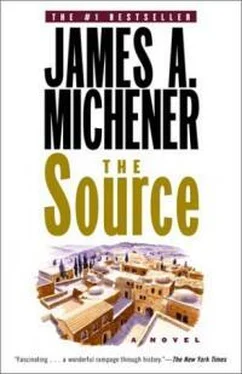The excavation of the various holes that would unite to form the water system required, as Hoopoe had predicted, a full three years. The first seventeen months were spent sinking the square main shaft, whose diagonal, twenty-nine feet across, Hoopoe took pains to keep aligned with the flags. In the beginning the great hole had to pass through the accumulated rubble of the mound, and the diggers uncovered relics first of the bronze age when the Hebrews were bringing El-Shaddai to the site, then of the earlier copper age when Canaanites were erecting monoliths to Baal, and finally of the stone age when the Family of Ur was first erecting its menhir to El. In the digging Hoopoe occasionally found some article of interest which he took to his wife, so that the main room of their home became lined with small shelves on which he placed old statues and bits of metal. It was his opinion—not shared by others—that down along the sides of the hole one could detect signs of many towns that had vanished, and he was particularly impressed with one solid band of black soot that reached across the entire area some eight feet under the surface. “I think that at this point Makor must have been burned away,” he told Meshab, and he recalled the poems and legends kept alive in his family regarding the fight between Baal and El-Shaddai which had ended in a general fire, but others were sure that if a town had burned so long ago its ashes would have washed away in the rain. They proved their argument by lighting a fire, making ash, and then washing it completely away with a bowl of water. Long after the experiment Hoopoe found the answer: “Of course you can wash away a little ash. It goes from here to there. But suppose everything is ash? Both here and there? Where then does it go?” But by that time the slaves were digging into solid rock.
It was here that Meshab the Moabite became so valuable. The rock of this area was a semi-soft limestone which when soaked with water could be worked like a hard clay. Iron-edged tools could be driven into it and huge chunks broken away, square-edged to be used in building houses later. It was Meshab who discovered the proper sequence for working the limestone: slant the floor of the hole in one direction so that water could seep into stony crevices, then excavate the portions over which the water had been standing, tilting the floor in the opposite direction. He also rigged the thick ropes that hauled out the quarried stone and built the two circular inclines that would take one set of women down to the well on one set of stairs while their sisters climbed up another flight that did not interfere with the first. Meshab became more than a foreman; in every respect he was Hoopoe’s second in command, and it was Hoopoe who finally suggested that he leave the slave camp and move into a small room at the rear of the new house so that he could be available throughout the night in case of emergency. At first Kerith did not like the idea of having a murderous slave so near at hand, but when she remembered the hovel in which he had been living she consented. The governor objected, but Hoopoe insisted that the project was too big and too important to go unguarded by the man who knew it best, so the tall Moabite took up his residence in the rear of the house. One night, as the two builders studied the gaping hole they had chopped into the earth, Hoopoe said, “Next week we start the tunnel. You go in from here. I’ll go in from the well and somewhere down there we’ll meet. At that moment, Meshab, I shall embrace you as a freed-man.” The slave said nothing, for he was wondering how he could keep his tunnel headed straight through the darkness, through the concentrations of solid rock. How could two men, starting from opposite directions, find each other in the bowels of the earth?
When the shaft was completed Hoopoe and Meshab stood at the bottom and looked upward at the small square of sky which showed its blue impartially by yielding no hint of direction, and Meshab said, “From here no range is visible. The well might lie in any direction,” and Hoopoe replied, “Would I have brought you so far if I did not have a secret?” And he led Meshab out of the well and out of the town to a spot far in the hills where tall trees grew, and he asked the slave, “How high is that one?” and Meshab judged the tall tree to be at least thirty cubits. “It will do,” Hoopoe said confidently and he sat down to wait while Meshab returned to Makor for a gang of slaves to chop down the tree; but when the Moabite was gone Hoopoe lost his sense of assurance and humbled himself before the tree, clutching its trunk with his hands and praying, “Baal-of-this-Tree, I depend on you to help us find our way.” And for the better part of an hour he prayed, an engineer seeking guidance from the tool he was about to use.
When the tree was felled and its branches trimmed away, the slaves began hauling it back to town, and when it was brought through the postern gate Hoopoe said, “Take it to the square shaft at once”; and there he placed it diagonally across the gaping square so that its direction duplicated the range established by the six flags; and since the range now passed directly along the tree, any tunnel that followed the line of the tree would have to intersect the well.
“Your job is to follow the tree,” Hoopoe told the Moabite.
“And how will I do that after the first day, when I can no longer see the tree above me?”
Then the genius of Hoopoe manifested itself, for he disclosed the secret he had been perfecting over the last two years. He asked for a ball of strong white cord, to one end of which he fastened a heavy stone. Then, going to the point where the tree formed the southern end of the diagonal, he tied the free end of the cord about the trunk and slowly allowed the rock to fall till it just touched the bottom of the shaft. Next he went to the northern end of the diagonal and repeated the process, so that now he had at the bottom of the shaft two rocks holding taut two perpendicular strings so placed that a line between them would exactly reproduce the line of the tree and therefore the range of the six flags. And now Hoopoe’s care in orienting his diagonal so precisely bore fruit, for by this device he had insured that the two strings would be as far apart as possible and thus give maximum protection against error. If Meshab could keep these two strings in line as he dug, he must find the well.
The Moabite, with a shout of joy—such as a hunter utters when he sees a deer, or a sea captain when he sees the harbor—cried, “It can be done!” And when he hurried down to the bottom of the shaft and saw what a clean, hard line the two taut strings provided, he said, “At night we can place two lamps at the foot of the strings, and we can see our way into the heart of the earth, no matter how dark it gets.” And he looked at the engineer, so like the hoopoe bird when he walked, and felt an inexpressible admiration for the intelligence of this man.
And so on a bright sunny morning in Ethanim of the second year—when summer had ended and only the major rivers found enough water to stay alive and when men waited for rain so they could plow their fields and sow their winter’s wheat—Meshab the Moabite hammered the first iron wedge into the limestone barrier separating the bottom of the shaft from the well, and for twelve months thereafter he would keep his men working away at the rock, digging a tunnel that slanted downward. At the first sledge blow Hoopoe prayed, “Baal, lead us through this darkness,” and aloft at the edge of the pit Kerith prayed, “Yahweh, bring him success that he may take me up to Jerusalem.”
Now Hoopoe moved to the well end, and there his problem was more difficult. Originally Makor had obtained its water from a spring which bubbled freely from the earth, but as the millennia passed two changes occurred: the earth about the lip of the spring grew upward year by year because of accumulated rubble; and during each century the chopping down of trees in the area—not many yet, but each year more and more—caused the actual water level to be drawn downward. These two agencies working in contrary directions meant that the surface of the spring sank lower and lower into the earth, so that by the time the first walls were built about the mound the spring had already become a well whose sides had to be dug constantly deeper and walled with stone.
Читать дальше








![Джеймс Купер - Пионеры, или У истоков Саскуиханны [The Pioneers, or The sources of the Susquehannah]](/books/395797/dzhejms-kuper-pionery-ili-u-istokov-saskuihanny-t-thumb.webp)

